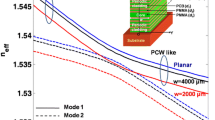Abstract
Photonic components are superior to electronic ones in terms of operational bandwidth, but the diffraction limit of light poses a significant challenge to the miniaturization and high-density integration of optical circuits. The main approach to circumvent this problem is to exploit the hybrid nature of surface plasmon polaritons (SPPs), which are light waves coupled to free electron oscillations in a metal1,2 that can be laterally confined below the diffraction limit using subwavelength metal structures3,4,5,6,7,8. However, the simultaneous realization of strong confinement and a propagation loss sufficiently low for practical applications has long been out of reach. Channel SPP modes—channel plasmon polaritons (CPPs)8—are electromagnetic waves that are bound to and propagate along the bottom of V-shaped grooves milled in a metal film. They are expected to exhibit useful subwavelength confinement, relatively low propagation loss9, single-mode operation10 and efficient transmission around sharp bends11. Our previous experiments showed that CPPs do exist and that they propagate over tens of micrometres along straight subwavelength grooves12. Here we report the design, fabrication and characterization of CPP-based subwavelength waveguide components operating at telecom wavelengths: Y-splitters, Mach–Zehnder interferometers and waveguide–ring resonators. We demonstrate that CPP guides can indeed be used for large-angle bending and splitting of radiation, thereby enabling the realization of ultracompact plasmonic components and paving the way for a new class of integrated optical circuits.




Similar content being viewed by others
References
Raether, H. Surface Plasmons (Springer, Berlin, 1988)
Barnes, W. L., Dereux, A. & Ebbesen, T. W. Surface plasmon subwavelength optics. Nature 424, 824–830 (2003)
Weeber, J. C. et al. Near-field observation of surface plasmon polariton propagation on thin metal stripes. Phys. Rev. B 64, 045411 (2001)
Takahara, J., Yamagishi, S., Taki, H., Morimoto, A. & Kobayashi, T. Guiding of a one-dimensional optical beam with nanometer diameter. Opt. Lett. 22, 475–477 (1997)
Quinten, M., Leitner, A., Krenn, J. R. & Aussenegg, F. R. Electromagnetic energy transport via linear chains of silver nanoparticles. Opt. Lett. 23, 1331–1333 (1998)
Maier, S. A. et al. Local detection of electromagnetic energy transport below the diffraction limit in metal nanoparticle plasmon waveguides. Nature Mater. 2, 229–232 (2003)
Tanaka, K. & Tanaka, M. Simulations of nanometric optical circuits based on surface plasmon polariton gap waveguide. Appl. Phys. Lett. 82, 1158–1160 (2003)
Novikov, I. V. & Maradudin, A. A. Channel polaritons. Phys. Rev. B 66, 035403 (2002)
Pile, D. F. P. & Gramotnev, D. K. Channel plasmon-polariton in a triangular groove on a metal surface. Opt. Lett. 29, 1069–1071 (2004)
Gramotnev, D. K. & Pile, D. F. P. Single-mode subwavelength waveguide with channel plasmon-polaritons in triangular grooves on a metal surface. Appl. Phys. Lett. 85, 6323–6325 (2004)
Pile, D. F. P. & Gramotnev, D. K. Plasmonic subwavelength waveguides: next to zero losses at sharp bends. Opt. Lett. 30, 1186–1188 (2005)
Bozhevolnyi, S. I., Volkov, V. S., Devaux, E. & Ebbesen, T. W. Channel plasmon-polariton guiding by subwavelength metal grooves. Phys. Rev. Lett. 95, 046802 (2005)
Kumar, A. & Aditya, S. Performance of S-bends for integrated-optic waveguides. Microw. Opt. Technol. Lett. 19, 289–292 (1998)
Bozhevolnyi, S. I. & Volkov, V. S. Near-field characterization of planar photonic-crystal-waveguide structures. Phil. Trans. R. Soc. Lond. A 362, 757–769 (2004)
Yariv, A. Universal relations for coupling of optical power between microresonators and dielectric waveguides. Electron. Lett. 36, 321–322 (2000)
Nikolajsen, T., Leosson, K. & Bozhevolnyi, S. I. Surface plasmon polariton based modulators and switches operating at telecom wavelengths. Appl. Phys. Lett. 85, 5833–5835 (2004)
Acknowledgements
This work was supported by the European Network of Excellence, PLASMO-NANO-DEVICES and STREP SPP.
Author information
Authors and Affiliations
Corresponding author
Ethics declarations
Competing interests
Reprints and permissions information is available at npg.nature.com/reprintsandpermissions. The authors declare no competing financial interests.
Rights and permissions
About this article
Cite this article
Bozhevolnyi, S., Volkov, V., Devaux, E. et al. Channel plasmon subwavelength waveguide components including interferometers and ring resonators. Nature 440, 508–511 (2006). https://doi.org/10.1038/nature04594
Received:
Accepted:
Issue Date:
DOI: https://doi.org/10.1038/nature04594
- Springer Nature Limited
This article is cited by
-
Surface acoustic wave actuated plasmonic signal amplification in a plasmonic waveguide
Discover Nano (2024)
-
Compensating losses in polariton propagation with synthesized complex frequency excitation
Nature Materials (2024)
-
Asymmetric dual-core liquid crystal channel-based tunable mode converter
Scientific Reports (2024)
-
Highly sensitive temperature sensor based on nematic liquid crystal channel waveguide on silicon
Optical and Quantum Electronics (2024)
-
Highly Confined Terahertz Surface Plasmons Generation in Graphene-Coated Optical Fiber by Nonlinear Mixing of Two Laser Beams
Plasmonics (2024)





